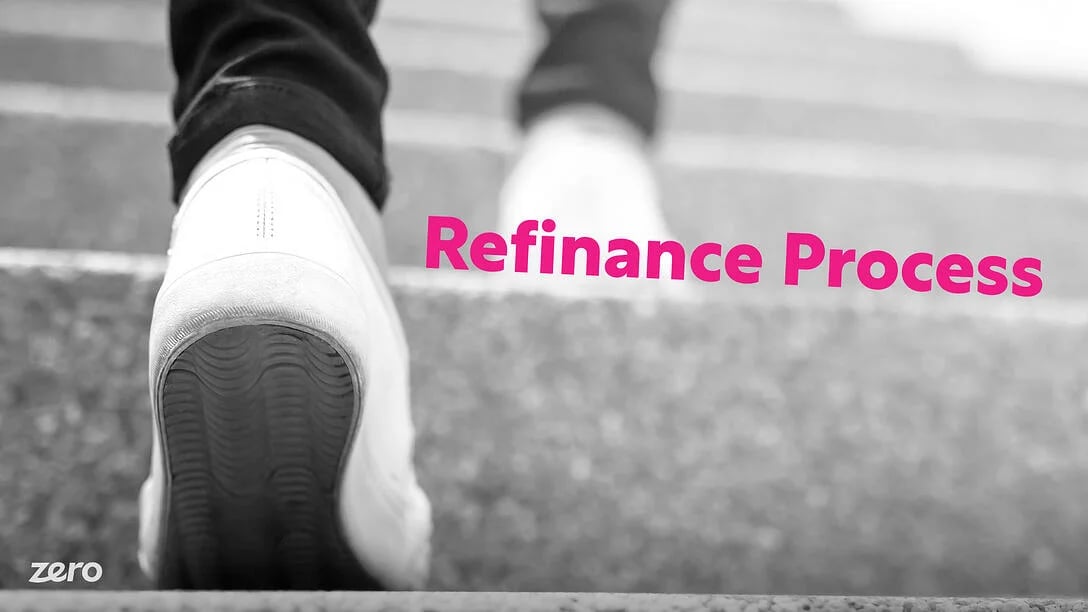How to Refinance a Mortgage: Refinancing Process Guide

Consider this scenario. You bought a house several years ago, and at the time, you thought you got a pretty great deal. However, since you closed on your new residence, interest rates have plummeted, and you’re wondering how you can benefit from them. Does this sound accurate? If so, you may be in the right position to consider refinancing your mortgage.
People refinance their homes for many reasons, including snagging lower interest rates, reducing house payments, shortening the loan term, and withdrawing money from a house’s equity.
If you’ve been wondering whether refinancing could benefit you, this is the guide you need. We’ll cover the reasons you might want to refinance, the process you’ll have to follow, and all the questions you’re probably asking
We've created a refinancing checklist to help you through this complex process, check it out here!
What Is Mortgage Refinancing?
Let’s start with a basic definition of refinancing. Essentially, mortgage refinancing is the process of swapping out your current loan for a new one with different terms. It’s a relatively simple idea, and people pursue it with a variety of different motivations. These are some of the most common.
Change Your Loan Type
One reason to refinance is to change your loan type. You might want to do this if you started with an adjustable-rate mortgage (ARM) and you’re tired of fluctuating interest rates and payments. A fixed-rate loan could give you the payment reliability you’re craving.
Lowering Interest Rates
As we mentioned before, snagging lower interest rates is a common reason to refinance. Even if your new interest rate will only drop by half a percent, it’s still a savvy investment—as long as you see yourself staying in the residence for several more years.
Pay off Your Mortgage Faster
If you’re in the financial position for it, refinancing to decrease the length of your loan—from 30 to 15 years, for example—can help you pay your loan off faster. A mortgage can be the most significant financial burden a person will take on in their life and paying it off can open up enormous possibilities for how you can spend your time and money. You may also be able to save additional money in the long-term by paying less interest on a shorter loan.
No More Private Mortgage Insurance (PMI)
PMI can be a massive drag on your monthly payment, but refinancing can help you get rid of it. If you originally had to pay PMI as a requirement from your lender because you put down less than 20% on your house, you can have it removed in a refinance if your revised loan meets an 80% threshold in terms of your home’s value.
When Should You Go Through the Mortgage Refinance Process
Deciding when to refinance a home or condo depends on so many different factors that are unique to you and your family. Considering the time and money involved with a refinance, it’s not something you should jump into without fully understanding that process and your motivations.
Is Condo Refinancing Right for You?
If you’re wondering about refinancing a condo, know that the process is largely similar to that of refinancing a house—though there are specific requirements your condo and association may have to meet.
Once a lender has determined that your condo is eligible for refinancing, the biggest thing is to look at how the process will benefit you and affect your financial goals. If you want to speed up your payoff timeline, cut your payments, or reduce your interest rate, for example, condo refinancing can be smart. If your reasons for refinancing are to borrow money from your home’s value to pay for other expensive necessities, a cash-out refinance can be a wise choice.
Would a Condo Refinance Leave You Better off?
A condo refinance could leave you in a better place if you make sure to do it at a time when interest rates are low, or if you do it to support your other long-term goals, such as funding your children’s college education or paying off your loan faster.
Calculate Your New Payment
Refinancing can affect your loan payment in both directions. Essentially, you can end up with a higher or lower monthly amount based on several different factors. You’ll just need to provide details such as the current balance of the loan and interest rate, how much time remains on the loan, and the new interest rate. There are many internet calculators that you can use to get an estimate of the new amount you’ll pay.
Common Questions About Refinancing
Refinancing can get complicated, and it’s normal to have a lot of questions about when to refinance and how it’ll affect your life. We’ll walk through some common questions below.
When Does It Make Sense to Refinance Your Mortgage?
If your main goal is to lower your interest rate, wait to refinance until doing so would bring your interest rate down by no less than half of a percentage point.
Here are a few other optimal situations:
- You’ve accumulated sufficient equity in your home to eliminate PMI.
- You want to get out of your adjustable-rate mortgage.
- You plan to stay living in your house long enough that your home value will increase enough that it will offset any expenses incurred through refinancing.
Is Refinancing Ideal During COVID-19?
You may feel uncertain about refinancing during an evolving pandemic, but in reality, this may be a great time to refinance. The Federal Reserve cut interest rates to give the economy a leg-up, which means mortgage rates have also gone down
Read our blog all about how COVID-19 has affected the homebuying process here.
How Does My Credit Score Affect Refinancing?
Has your credit score improved since you first bought your home? You may want to jump on a refinance as a better credit score can get you better rates and reduce the amount of money you pay.
Is Refinancing Available for FHA, VA, Jumbo, or USDA loans?
If you have a USDA, Jumbo, FHA, or VA loan, you can also choose to refinance and potentially get a lower rate. One option to lower monthly payments for FHA loans is the FHA Streamline Refinance Program, which allows you to forgo income/credit score verification and appraisal. However, the streamline program has specific requirements, such as a certain amount of on-time payments, and limitations, such as the inability to pursue a cash-out refinance. You also won’t have the option to finance your closing costs, and you will be liable for mortgage insurance premiums.
What documents do you need to have to refinance your mortgage? Find out here.
How to Refinance Your Mortgage
Now that you’ve learned what’s involved in refinancing a mortgage, let’s move on to what refinancing looks like in practice.
Step 1: Set Clear Financial Goals
Don’t start refinancing without knowing exactly why you’re making this switch and what the outcome may be. If you’re doing a cash-out refinance, know that your loan amount will go up. If you’re shortening your loan term from 30 to 15 years, know that your payments may be higher. Each option has a tradeoff, but there’s no need to fret about the cons if you’re secure in your decision.
Step 2: Review Your Credit Score and History
How is your credit? You must know where you stand with your credit score before starting the refinance process since your credit score has bearing on the quality of the rates you get.
Step 3: Figure out How Much Home Equity You Have
The higher your equity, the better chance you have of getting outstanding rates. Be sure to check your home equity as part of your refinance prep work by subtracting the amount you owe on your home from its current approximate value.
Step 4: Shop Multiple Mortgage Lenders
Don’t necessarily go with the first lender you find. Instead, shop around to find the best rates and compare fees from one lender to the next. The extra time spent researching could end up saving you money.
Step 5: Prepare for the Appraisal
Depending on the particular mortgage lender you work with, you might have to have your home appraised before you can refinance. The cost of this appraisal will add to the amount of money you need to pay during the process.
Step 6: Come to the Closing with Cash, if Needed
There’s no such thing as a free lunch—or a free refinance. When you go to close on your loan, you need to take additional fees into account. Building the costs into the loan, when possible, can also make your loan or your rates higher, so consider whether this tradeoff is worth it in the long run.
Our Mortgage Learning Center features blogs on a wide range of mortgage and refinancing topics.
Next Steps: Getting the Best Refinance Rate
Is refinancing right for you? After reading this article, you should understand when the best times to consider a refinance are and how it can benefit you, from securing you a lower interest rate to removing the burden of PMI. When you’re ready, take the next step by reaching out to a reputable mortgage company to find out what kind of rates you could obtain.
Is It Time to Refinance?
This page last updated: October 6, 2022
Read more on this topic below.

A mortgage is often the largest monthly expense homeowners pay. The thought of reducing the amount...

It’s likely that your mortgage loan will be the largest loan you have during your lifetime. Mortgages are not a one size...

Refinancing your home can save you thousands of dollars per year! When you extrapolate that savings over...

A loan estimate is crucial to obtain when looking for a loan. This estimate not only gives you the details of a mortgage but also compares offers...

If you’re looking to buy a house, and do not have a mountain of cash saved up, you’ll need to consider getting a mortgage to help you finance this...

Whenever you are borrowing money, whether it’s for a new mortgage, a refinance, credit card, or car loan, you’ll hear...

Refinancing can open up opportunities for homeowners to cash out on equity, reduce monthly mortgage payments, or renegotiate the interest...

The interest rate on a mortgage is simply the fee a lender charges the borrower for borrowing their money. Over the...

A cash-out refinance is the process of taking the equity you have built in your home in the form of a cash deposit into a designated account...
